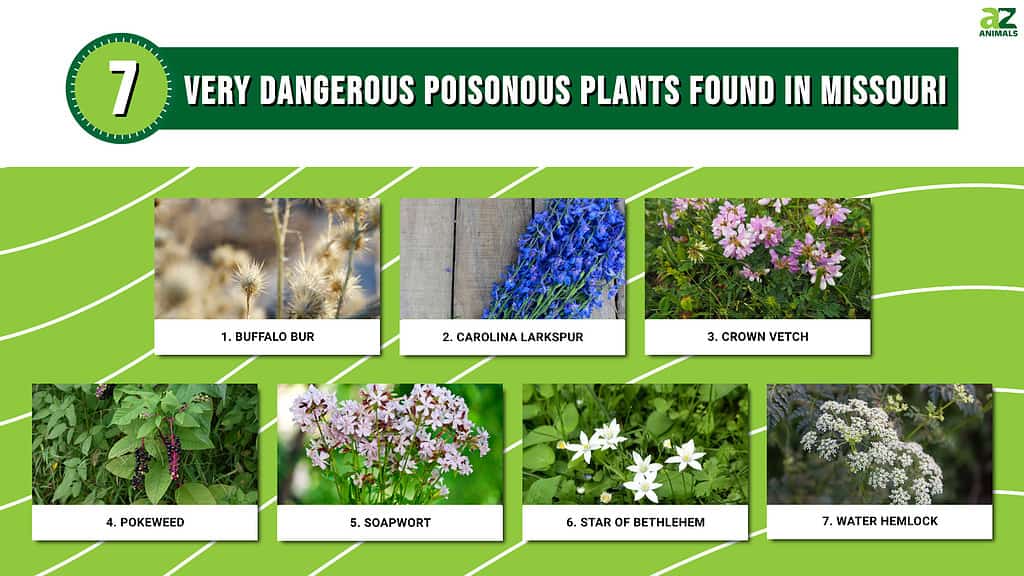
Many of these plants could cause allergic reactions from touching them.
©
Missouri is a midwestern state full of native plants across its prairies, grasslands, and riverbanks. Unfortunately, some of these native plants are poisonous to humans and pets. The good news is that the Missouri Department of Conservation identifies many of the state’s plants that could cause people and animals harm. Based on this research, we’ve pulled together a list of seven poisonous plants found in Missouri that are very dangerous if ingested. Some of these plants could also cause allergic reactions from touching them.
In addition to poisonous plant information, see below for how to get support with plant poisoning symptoms for the most dangerous plants in the United States.
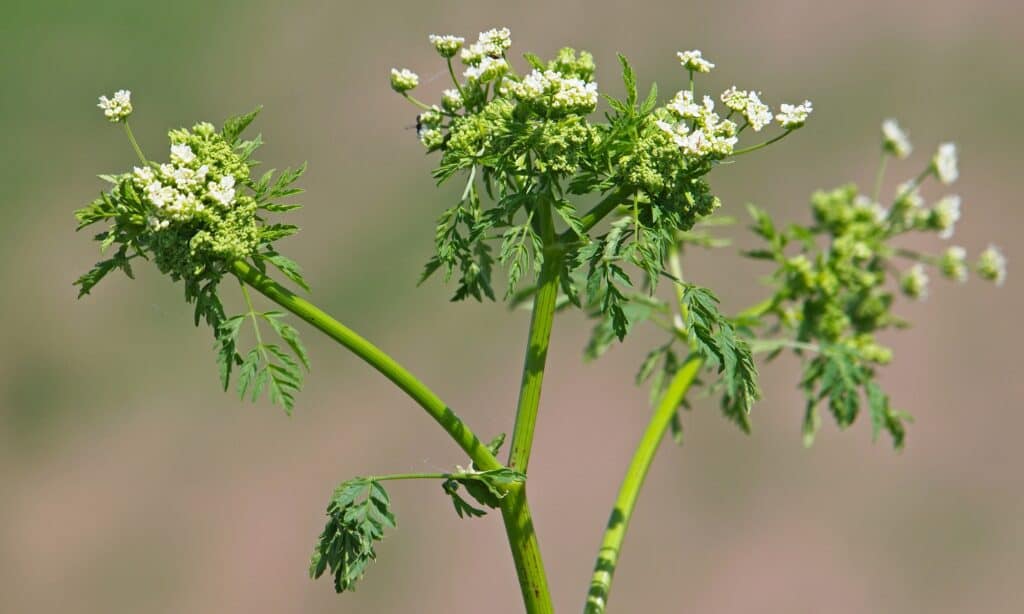
Hemlock is one of the most poisonous plants found in Missouri.
©iStock.com/emilio100
Plant Poisoning Resources and Support
Poison Control provides a confidential and free phone number for quick help with symptoms of poisonous plant exposure. Or you can check out the CDC guidelines for additional protocols.
How to Avoid Poisonous Plants
Take extra precautions when spending time around plants that aren’t familiar to you, especially when picking them. Various wildflowers, grasses, bushes, and berries could have toxins that easily rub onto your skin or clothes. And ingesting them could bring on far worse symptoms.
We recommend bringing a small bag or backpack with a trustworthy plant identification guide and first aid kit. Also, make sure your first aid kit has degreasing soap, wipes, and creams formulated for skin rash relief and wound care.
To prevent exposure to poisonous plants, wear protective clothes like closed-toe shoes, gardening gloves, long sleeves, and long pants outdoors.
Keep children and pets away from plants that aren’t familiar to you, and know that some plants in your garden could also be poisonous. For example, daffodils have a toxin called lycopene that can cause mild to severe allergic reactions if touched or ingested.
Finally, always wash your hands and clothes after touching unfamiliar or poisonous plants.
Onward to seven poisonous plants found in Missouri that could be very dangerous if eaten, touched, or both.

The
buffalo
bur plant is prickly, poisonous, and invasive.
©cctm/Shutterstock.com
1. Buffalo Bur
- Scientific Name of Plant: Solanum rostratum
- Common Names of this Plant: Buffalo bur, Kansas thistle, Texas thistle, Colorado bur, horned nightshade, spiny nightshade
- Plant Description: A buffalo bur plant has deeply lobed leaves and branching stems covered in sharp, spiny hairs that prick the skin like thorns. This poisonous plant also produces yellow flowers, red berries, and sharp burs around its mature seed pods.
- Plant Height: Buffalo bur grows 3-4 feet tall.
- Habitat of This Plant: The buffalo bur grows along roadsides and disturbed areas like overgrown pastures, waste areas, and fields. This plant thrives in dry and sandy soil.
- Toxic Parts of Plant: Avoid all parts of this plant throughout its entire life cycle, but the green berries and leaves contain the most toxin.
- Symptoms of Plant Poisoning: Eating any part of the buffalo bur plant could cause dry mouth, drowsiness, diarrhea, nausea, vomiting, trembling, confusion, blurred vision, labored breathing, weakness, unconsciousness, and possibly death.
Watch out for the buffalo bur plants that grow in Missouri and across the Plains states. Not only are they poisonous, but they’re also covered with sharp and thorn-like hairs. Plus, the mature plants produce seed pod burs that easily get stuck to skin, clothing, and animal fur.
Unfortunately, this dangerous Missouri plant is very invasive, especially in areas with dry and sandy soil.
Because it’s a thorny plant with prickly burs, most people and animals stay away from it. But the biggest danger is to grazing animals that might accidentally eat or brush against these noxious weeds.
The USDA states that the severity of symptoms from buffalo bur poisoning can vary depending on the local climate and condition of the soil where it grows. Symptoms can also depend on the part of the plant ingested and when. For example, the berries of this plant become less toxic the more they mature. However, eating any portion of this plant (especially the leaves and green berries) can result in life-threatening symptoms like labored breathing and respiratory paralysis.
Buffalo Bur Toxic Ingredients
The buffalo bur plant contains a toxin called solanine, a type of glycoalkaloid toxic to humans and most animals if ingested. Moreover, buffalo bur poisoning could be fatal, so destroying and keeping these plants out of areas where animals graze is important.
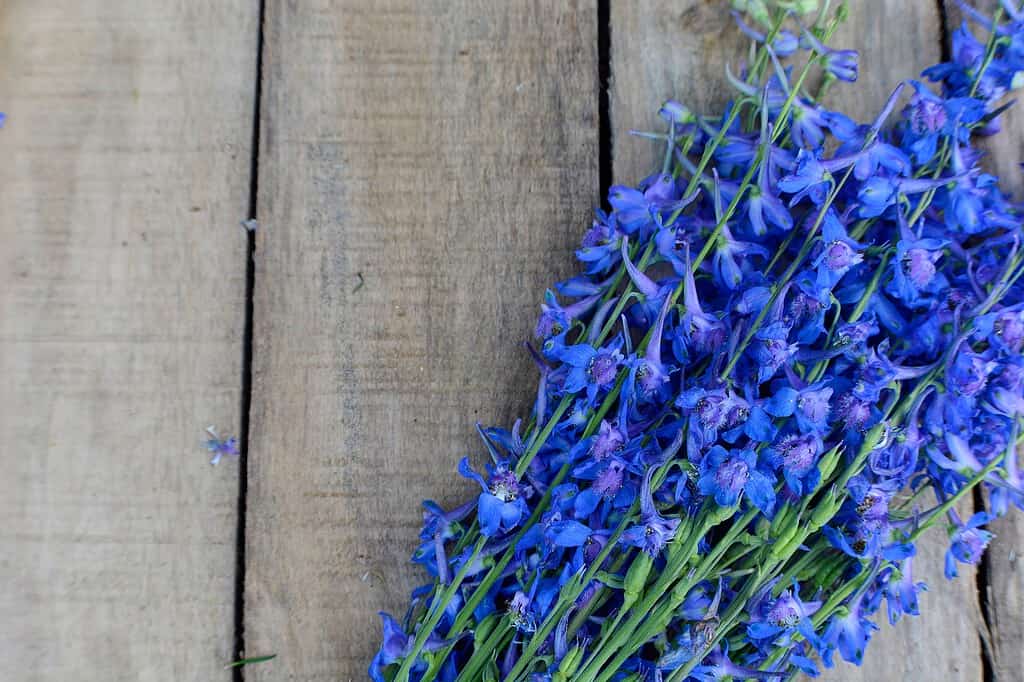
Wildflower Carolina larkspur contains toxic alkaloids that make this plant dangerous if ingested.
©dawnstanley92/Shutterstock.com
2. Carolina Larkspur
- Scientific Name of Plant: Delphinium carolinianum
- Common Names of this Plant: Carolina larkspur, Delphinium, wild larkspur, prairie larkspur
- Plant Description: The Carolina larkspur is a non-branching upright plant with long stems that produce white or bluish-purple flowers, depending on the variety. It’s also a perennial wildflower that comes back every year.
- Plant Height: Carolina larkspur grows 1-2 feet tall.
- Habitat of This Plant: The Missouri Department of Conservation states that Carolina larkspur commonly grows in fields, prairies, meadows, and rocky slopes.
- Toxic Parts of Plant: Avoid all parts of this and other larkspur plants, especially the seeds and any parts with new growth.
- Symptoms of Plant Poisoning: Touching any larkspur plant could cause skin irritation. The symptoms of ingesting any part of any variety of larkspur plants include bloating, excessive salivation, muscle twitching, rapid or abnormal heartbeat, a staggering gait, weakness, and possibly death.
Carolina larkspur is a beautiful wild plant that is tasty to cows. But when the USDA claims that larkspur poisoning in cattle often results in death, you know this plant found in Missouri is very dangerous.
Fortunately, people and most grazing animals (like horses and sheep) aren’t as interested in snacking on Carolina larkspur as cows are. Yet this pretty blue or white wildflower requires a serious warning just the same. This warning is because ingesting the alkaloids of poisonous larkspur plants could be fatal for any of us.
According to the Missouri Botanical Garden, the Carolina larkspur belongs to the buttercup family and blooms from April to June in Zones 4-7. This poisonous plant also attracts butterflies and hummingbirds to its nectar.
Toxic ingredients in Carolina Larkspur
Toxic alkaloids in Carolina larkspur include ajaconine and delcaroline. Because of these toxic compounds, the Carolina larkspur is one of the most poisonous plants found in Missouri.
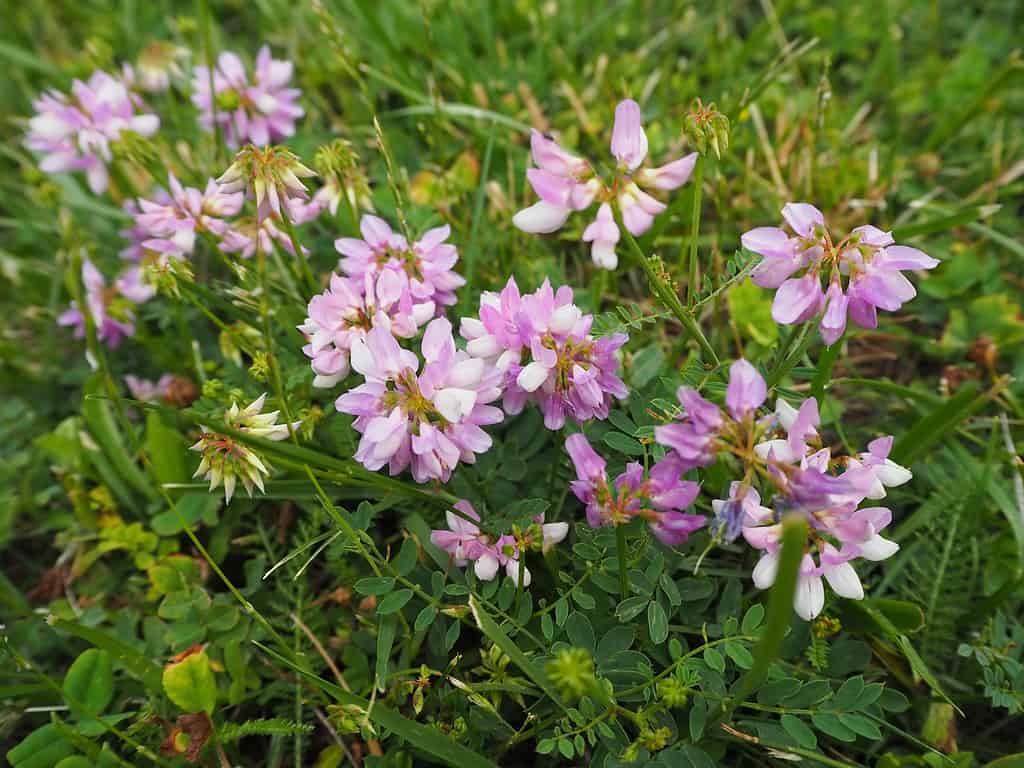
The crown vetch plant is toxic mainly for humans and other non-ruminant animals.
©mirti/Shutterstock.com
3. Crown Vetch
- Scientific Name of Plant: Securigera varia
- Common Names of this Plant: Crown vetch, crownvetch, purple crown vetch
- Plant Description: The crown vetch plant creates a mass of clumping and creeping stems with umbels (flower clusters) that are usually pink and white. Crown vetch flowers resemble those of pea plants and have a subtle, pleasing fragrance. In addition, this plant produces long leaves consisting of 15-25 leaflet pairs.
- Plant Height: The typical crown vetch in Missouri is low-growing and only reaches about 9 inches high. However, this vining plant has creeping stems up to 6 feet long and rhizomes reaching up to 10 feet long.
- Habitat of This Plant: Crown vetch thrives in sunny areas like fields and along the sides of roads.
- Toxic Parts of Plant: Avoid ingesting any part of the crown vetch plant, especially its leaves, and seeds.
- Symptoms of Plant Poisoning: Ingesting any part of the crown vetch plant can cause nausea, vomiting, diarrhea, involuntary muscle contractions, irregular heartbeat, weakness, cardiac arrest, a coma, and even death.
Invasive and poisonous crown vetch plants are herbaceous legumes related to peas. They have strong roots that are advantageous for erosion control but tend to take over any area they inhabit. Moreover, these Missouri poisonous plants are very dangerous because they contain potentially fatal toxins.
Crown vetch is also a pretty wildflower with pea-like blooms in white and pink.
Toxic Ingredients in Crown Vetch
The crown vetch plant contains a toxic substance called beta-Nitroproprionic acid, also called 3-Nitroproprionic acid. This substance is a type of mycotoxin, which means it’s a toxin formed by fungus.
Beta-Nitroproprionic acid is toxic to humans and other non-ruminant animals.* Though some ruminant animals might also suffer adverse effects, these animals aren’t as vulnerable to crown vetch poisoning.
Poisoning from 3-Nitroproprionic acid could cause involuntary muscle contractions (a condition called dystonia), weakness, nausea, vomiting, a coma, and could result in death.
The seeds of crown vetch also contain steroids called cardenolides. Consuming cardenolides could cause an abnormal heartbeat and cardiac arrest that might become fatal.
*Non-ruminant animals have only one stomach chamber, as humans have. Ruminant animals, like cows, have multi-chambered stomachs that allow them to regurgitate food to chew it again.
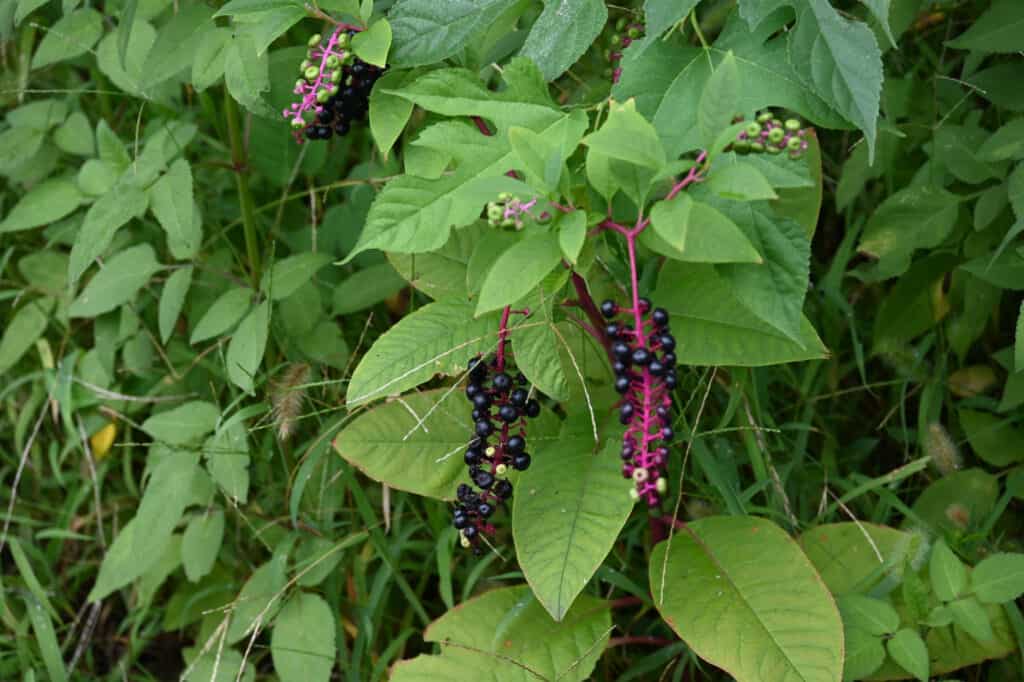
Eating any part of the poisonous pokeweed could cause symptoms like nausea, muscle spasms, and unconsciousness.
©tamu1500/Shutterstock.com
4. Pokeweed
- Scientific Plant Name: Phytolacca Americana
- Common Name: Pokeweed, American nightshade, American pokeberry, pigeon berry, poke salad, skoke
- Plant Description: The pokeweed shrub is probably most recognizable by its long clusters of poisonous berries that start green and mature to dark purple by summer’s end. Before they become berries, pokeweed flowers emerge in spring with greenish-white or pinkish-purple flowers. Additional features of this poisonous plant include its burgundy stems that look like they were soaked in red wine. Pokeweed also has long and shiny oval green leaves.
- Mature Height: Pokeweed shrubs usually grow between 4-10 feet high but can grow taller.
- Common Habitat: Waste grounds, fields, forest edges, woodlands, and pastures
- Poisonous Parts of the Plant: Avoid all parts of pokeweed shrubs (but especially the roots and seeds), whether the plant is dead or alive.
- Symptoms of Plant Poisoning: Touching any parts of the pokeweed shrub can cause redness, itchy rashes, and blisters. Eating any part of the pokeweed plant could result in developing headaches, nausea, vomiting, diarrhea, muscle spasms, difficulty breathing, convulsions, and unconsciousness.
According to the University of Missouri Division of Plant Sciences, pokeweed is a perennial weed with most of its toxicity in the roots. However, the pokeweed or pokeberry shrub is also a good example of why you should never eat or even touch the berries of unfamiliar plants. Though the dark, mature pokeweed berries aren’t quite as toxic as the green ones, they all could make you very sick if ingested.
And unfortunately, touching any part of this dangerous plant could lead to blistering rashes. Or the symptoms could be worse if pokeweed toxins seep into your skin through a scrape or wound. So it’s best to approach pokeweed shrubs with a lot of caution while wearing protective clothing.
Pokeweed Toxic Ingredients
The pokeweed toxins that make this poisonous plant found in Missouri very dangerous include phytolaccatoxin (a saponin) and oxalic acid. These dangerous compounds cause symptoms like burning sensations, nausea, vomiting, convulsions, and more.
Did you know that saponins, like those found in pokeweed, are compounds that can create a soap-like froth? The name saponin comes from the scientific name of the soapwort plant, which is a plant with a lathering sap. Keep reading to learn more about this fascinating poisonous plant in Missouri!

Pretty soapwort plants can make natural soap, but they are toxic if ingested.
©Snowbelle/Shutterstock.com
5. Soapwort
- Scientific Plant Name: Saponaria officinalis
- Common Name: Wild Sweet William, soapwort, soap weed, bouncing bet, crow soap
- Plant Description: Soapwort is an upright and non-branching perennial plant with 4-inch long leaves growing opposite each other on round stems. The soapwort also produces pretty clusters of pink or white flowers that resemble phlox and smell divine. In addition, each flower has long and spreading petals that become more reflexed as the flowers mature.
- Mature Height: Soapwort typically grows 1-2 feet tall
- Common Habitat: Banks of rivers and streams, fields, pastures, roadsides, meadows, and disturbed open areas like old homesites
- Poisonous Parts of the Plant: Avoid eating any parts of the soapwort plant, and don’t use it as a soap for pets or livestock.
- Symptoms of Plant Poisoning: Eating soapwort could lead to abdominal pain, nausea, vomiting, diarrhea, and mild depression. Also, eating large amounts of this plant (a possibility for grazing animals) could lead to liver damage (hepatotoxicity) and death. Note that symptoms of soapwort poisoning might not appear until several days after ingestion.
Soapwort is a pretty wildflower with long-lasting white or pink blooms. And boiling soapwort leaves and stems with water can create a natural soap! However, the same compounds in soapwort that make soap lather are the same ingredients that make this native Missouri plant toxic.
The Missouri Department of Conservation states that soapwort plants are poisonous and invasive. So think twice before growing it on your property unless you can keep it from spreading like mad across the landscape.
Soapwort Toxic Ingredients
Like pokeweed, soapwort plants produce a juice or sap containing saponin (a glycoside) that can cause mild to very dangerous toxicity symptoms in humans and animals if ingested.
Keeping Soapwort Away From Animals
Perhaps the biggest reason soapwort could be very dangerous is the ingestion of this plant by pets and livestock. Fortunately, the plant doesn’t taste good. So most Missouri animals won’t eat it. However, soapwort can be ingested by pets and livestock in accidental ways, including the following:
- Washing pets with natural soapwort soap can leave this plant’s sap residue in their fur. This situation is problematic because animals might get the residue in their mouths when grooming themselves.
- Grazing livestock (like horses, cattle, sheep, and goats) sometimes accidentally eat soapwort plants as they graze their way through overgrown pastures and fields.
So recognizing and controlling soapwort plants growing near your animals is essential to protect pets and livestock from harm.
Additionally, saponins from soapwort are also toxic to fish. Since the sap from this plant could get into the water, it’s best to avoid growing soapwort near artificial fish ponds and natural fish habitats.
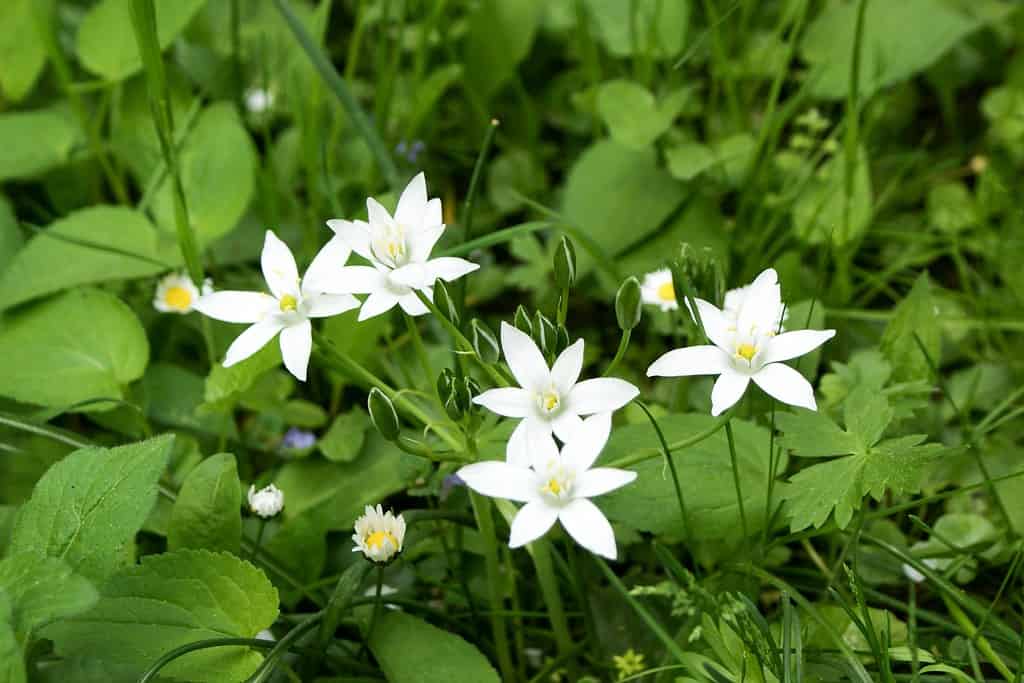
Grazing animals are vulnerable to poisoning from the star of Bethlehem plant.
©Joerg-alois/Shutterstock.com
6. Star of Bethlehem
- Scientific Name of Plant: Ornithogalum umbellatum
- Common Plant Names: Star of Bethlehem, summer snowflake, starflower, snowdrop, grass lily
- Plant’s Description: The Star of Bethlehem flowering plant grows in clumps with long narrow leaves that look like thick blades of grass. Its small white flowers are star-shaped and grow about one inch wide. Each stem of this perennial produces 10-20 blooms in spring through early summer.
- Plant Height: Usually about 1 foot tall
- Plant Habitat: The Star of Bethlehem prefers moist to wet soil and often grows near streams and rivers. This plant also thrives in wet meadows, pastures, and along the edge of floodplain forests.
- Toxic Parts of This Plant: Avoid eating all parts of this plant, though the highest concentration of toxin is in the bulbs. Unfortunately, the bulbs also resemble white onions. To avoid mistaken identity, don’t grow Star of Bethlehem plants near a garden patch of onions.
- Symptoms of Plant Poisoning: According to the USDA, ingesting any part of this plant could cause the following symptoms: nausea, vomiting, diarrhea, depression, excessive salivation, bloody urine, difficulty breathing, kidney hemorrhage, and respiratory failure. Severe cases could also include an abnormal heartbeat and cardiac arrest.
The Star of Bethlehem plant is part of the asparagus family (though formerly in the lily family). It fills with beautiful white blooms in mid to late spring. However, despite its attractive star-shaped flowers, this is one of the poisonous plants found in Missouri that could be deadly if ingested. It’s also an invasive plant that spreads from gardens to fields, roadsides, and areas with moist soil.
Be aware that this plant’s bulbs look so much like white onion bulbs that people sometimes mistakenly eat them. Grazing animals might also eat various parts of this plant. Additionally, the star of Bethlehem plants are toxic for pets, so it’s wise to grow them away from areas where your children and pets play outdoors.
Star of Bethlehem Toxic Ingredients
The Star of Bethlehem plant contains a set of steroids called cardenolides (components of cardiac glycosides) that are toxic to humans and animals when ingested.
Though these compounds are sometimes used in heart medicines to slow the heart rate, eating any part of this plant could be lethal for humans and their pets.

Water hemlock is a highly poisonous and deadly plant if eaten by humans or animals.
©iStock.com/gabrielabertolini
7. Water Hemlock
- Scientific Name of Plant: Cicuta maculata
- Common Plant Names: Water hemlock, poison hemlock, spotted water hemlock, spotted cowbane, spotted parsley
- Plant’s Description: The water hemlock has long, hollow, and spotted erect stems that produce long leaves with lanced edges. In addition, this plant’s tiny white flowers grow in umbels (rounded clusters with a flat top) that are 2-5 inches wide. Water hemlock looks similar to Queen Anne’s Lace or wild carrot plants.
- Plant Height: Water hemlock grows 3-8 feet tall.
- Plant Habitat: This very dangerous plant grows in wet soil and thrives in areas near water. You can find water hemlock near rivers, streams, lakes, ponds, and bottomland forests and prairies.
- Toxic Parts of This Plant: Avoid all parts of the water hemlock plant and never eat it.
- Symptoms of Plant Poisoning: Touching water hemlock doesn’t usually cause symptoms unless its toxins seep through a skin wound. However, some people might have a skin sensitivity to this plant, resulting in a rash. Eating any part of the water hemlock plant could quickly become deadly. Additional symptoms include convulsions, dry mouth or excessive salivating, muscle pain, muscle weakness, muscle paralysis, severe abdominal pain, vomiting, seizures, abnormal heartbeat, and kidney failure. It is vital to get immediate emergency medical attention for hemlock poisoning.
Water or poison hemlock is a tall, slender plant topped with clusters of tiny white flowers that look like Queen Anne’s lace. However, it’s important that you don’t confuse water hemlock with any other plant to avoid accidental poisoning.
This poisonous plant found in Missouri is one of the most dangerous plants in North America. The harmful effects of eating water hemlock could cause death within a few hours.
Toxic Ingredients in Water Hemlock
Water hemlock tubers, green seeds, young leaves, and stems contain a highly toxic unsaturated alcohol called cicutoxin. This toxin can quickly bombard the central nervous system, resulting in severe symptoms like convulsions, seizures, and respiratory failure leading to death.
Poisonous plants in Missouri can be very dangerous for humans and animals.
Among Missouri’s safe and beneficial wild plants live some dangerous ones that could cause harm to people, their pets, and their grazing livestock. Fortunately, there are many dependable resources for identifying these poisonous plants when out in nature. So enjoy your outdoor adventures more by learning to recognize and avoid the dangerous plants in Missouri and other states. Plus, carefully clear these plants away from areas where your pets and grazing animals roam.
Summary Of 7 Very Dangerous Poisonous Plants Found In Missouri
| Rank | Dangerous Plant |
|---|---|
| 1 | Buffalo Bur |
| 2 | Carolina Larkspur |
| 3 | Soapwort |
| 4 | Pokeweed |
| 5 | Soapwart |
| 6 | Star of Bethlehem |
| 7 | Water Hemlock |
The photo featured at the top of this post is © Southern Wind/Shutterstock.com
Thank you for reading! Have some feedback for us? Contact the AZ Animals editorial team.






